engine coolant DODGE DURANGO 2004 2.G User Guide
[x] Cancel search | Manufacturer: DODGE, Model Year: 2004, Model line: DURANGO, Model: DODGE DURANGO 2004 2.GPages: 386, PDF Size: 6.22 MB
Page 308 of 386
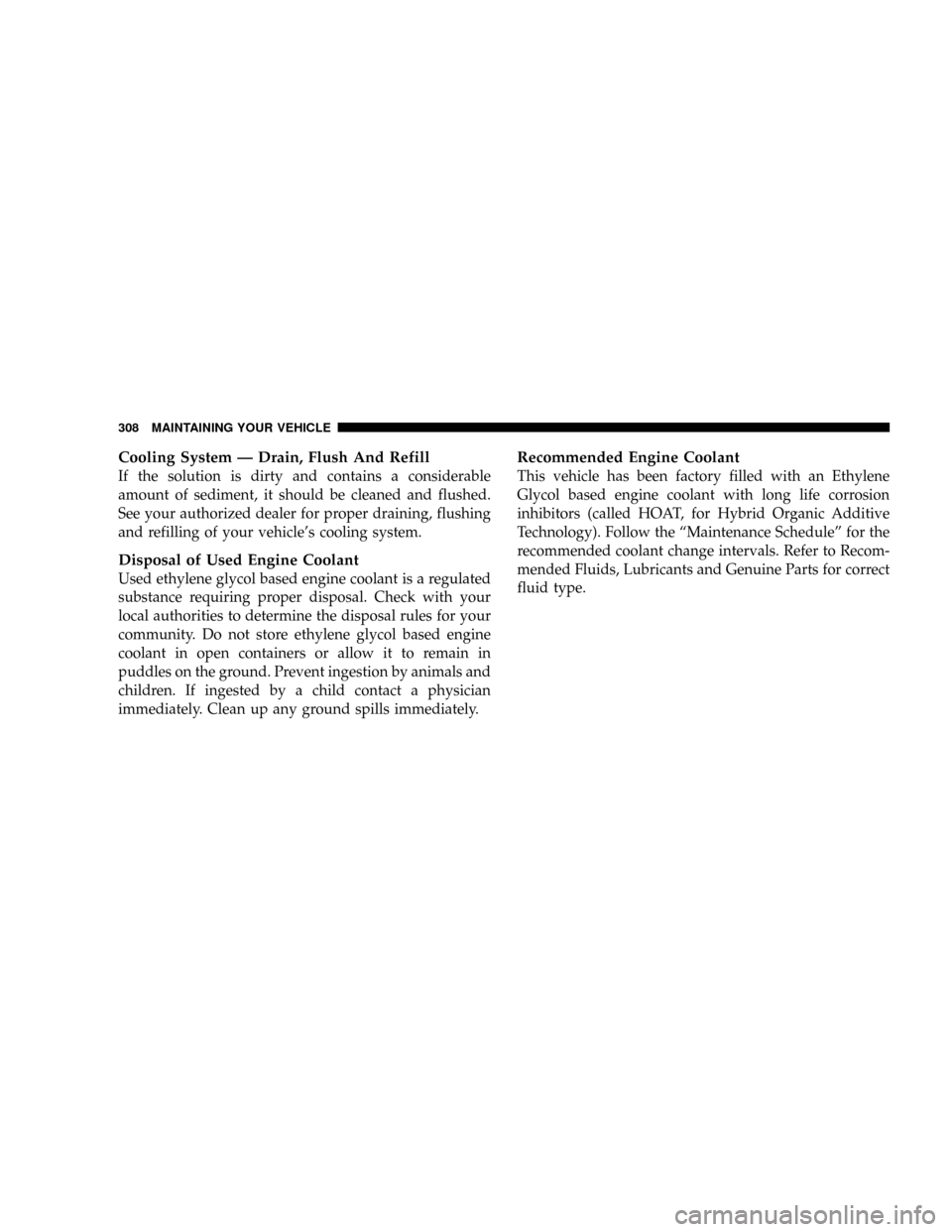
Cooling System Ð Drain, Flush And Refill
If the solution is dirty and contains a considerable
amount of sediment, it should be cleaned and flushed.
See your authorized dealer for proper draining, flushing
and refilling of your vehicle's cooling system.
Disposal of Used Engine Coolant
Used ethylene glycol based engine coolant is a regulated
substance requiring proper disposal. Check with your
local authorities to determine the disposal rules for your
community. Do not store ethylene glycol based engine
coolant in open containers or allow it to remain in
puddles on the ground. Prevent ingestion by animals and
children. If ingested by a child contact a physician
immediately. Clean up any ground spills immediately.
Recommended Engine Coolant
This vehicle has been factory filled with an Ethylene
Glycol based engine coolant with long life corrosion
inhibitors (called HOAT, for Hybrid Organic Additive
Technology). Follow the ªMaintenance Scheduleº for the
recommended coolant change intervals. Refer to Recom-
mended Fluids, Lubricants and Genuine Parts for correct
fluid type.
308 MAINTAINING YOUR VEHICLE
Page 309 of 386

CAUTION!
Mixing of coolants other than specified (non-
HOAT), may result in engine damage that may not
be covered under the new vehicle warranty, and
decreased corrosion protection. If a non-HOAT cool-
ant is introduced into the cooling system in an
emergency, it should be replaced with the specified
coolant as soon as possible.
Do not use plain water alone or alcohol base anti-
freeze products. Do not use additional rust inhibi-
tors or antirust products, as they may not be compat-
ible with the radiator coolant and may plug the
radiator.
This vehicle has not been designed for use with
Propylene Glycol based coolants. Use of Propylene
Glycol based coolants is not recommended.
Adding Coolant
When adding coolant or refilling system, a 50% solution
of ethylene glycol antifreeze coolant in water should be
used. Higher concentrations (not to exceed 65%) are
required if temperatures below -37ÉF (-38ÉC) are antici-
pated.
Use only high purity water such as distilled or deionized
water when mixing the water/antifreeze solution. The
use of lower quality water will reduce the amount of
corrosion protection in the engine cooling system.
NOTE:It is the owner's responsibility to maintain the
proper level of protection against freezing according to
the temperatures occurring in the area where the vehicle
is operated.
MAINTAINING YOUR VEHICLE 309
7
Page 310 of 386
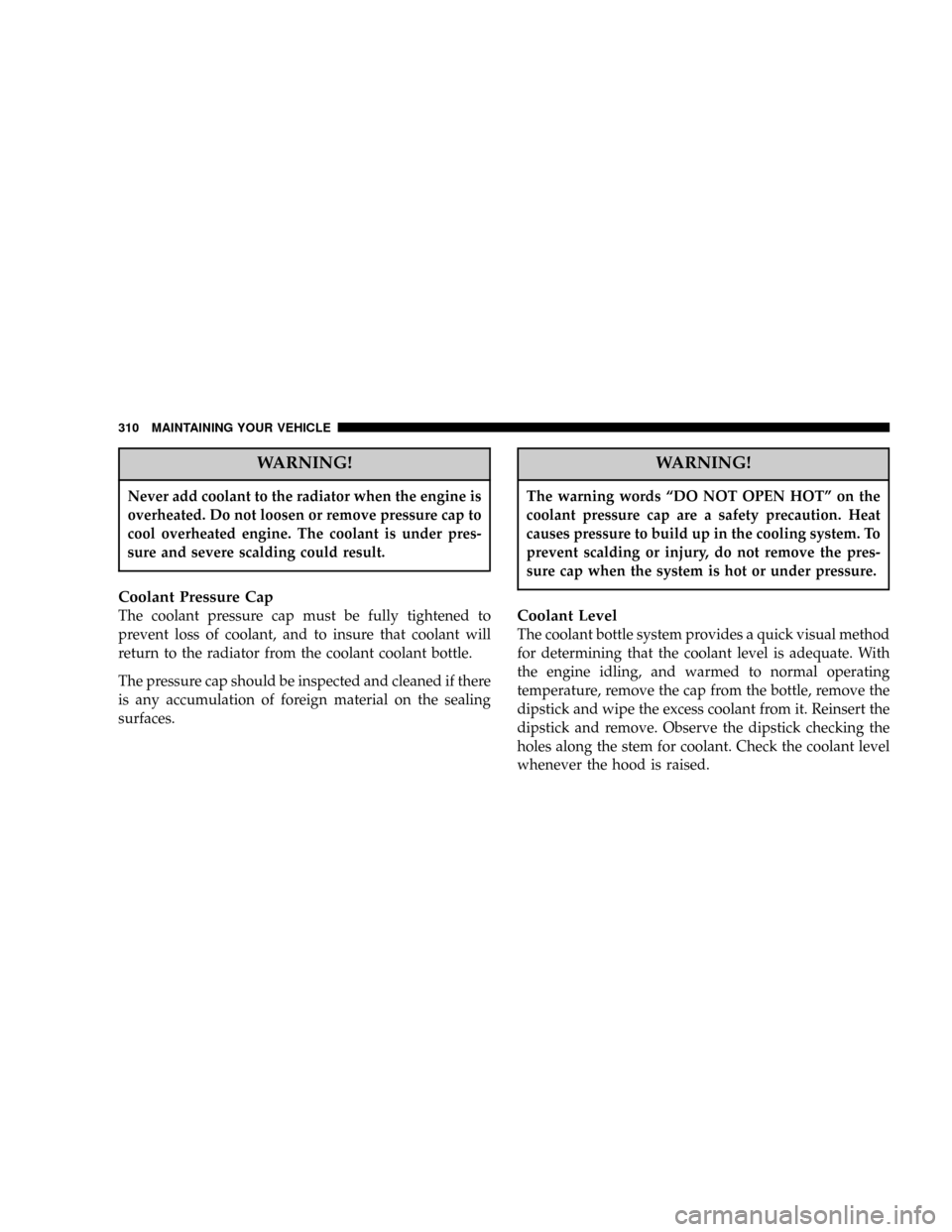
WARNING!
Never add coolant to the radiator when the engine is
overheated. Do not loosen or remove pressure cap to
cool overheated engine. The coolant is under pres-
sure and severe scalding could result.
Coolant Pressure Cap
The coolant pressure cap must be fully tightened to
prevent loss of coolant, and to insure that coolant will
return to the radiator from the coolant coolant bottle.
The pressure cap should be inspected and cleaned if there
is any accumulation of foreign material on the sealing
surfaces.
WARNING!
The warning words ªDO NOT OPEN HOTº on the
coolant pressure cap are a safety precaution. Heat
causes pressure to build up in the cooling system. To
prevent scalding or injury, do not remove the pres-
sure cap when the system is hot or under pressure.
Coolant Level
The coolant bottle system provides a quick visual method
for determining that the coolant level is adequate. With
the engine idling, and warmed to normal operating
temperature, remove the cap from the bottle, remove the
dipstick and wipe the excess coolant from it. Reinsert the
dipstick and remove. Observe the dipstick checking the
holes along the stem for coolant. Check the coolant level
whenever the hood is raised.
310 MAINTAINING YOUR VEHICLE
Page 311 of 386
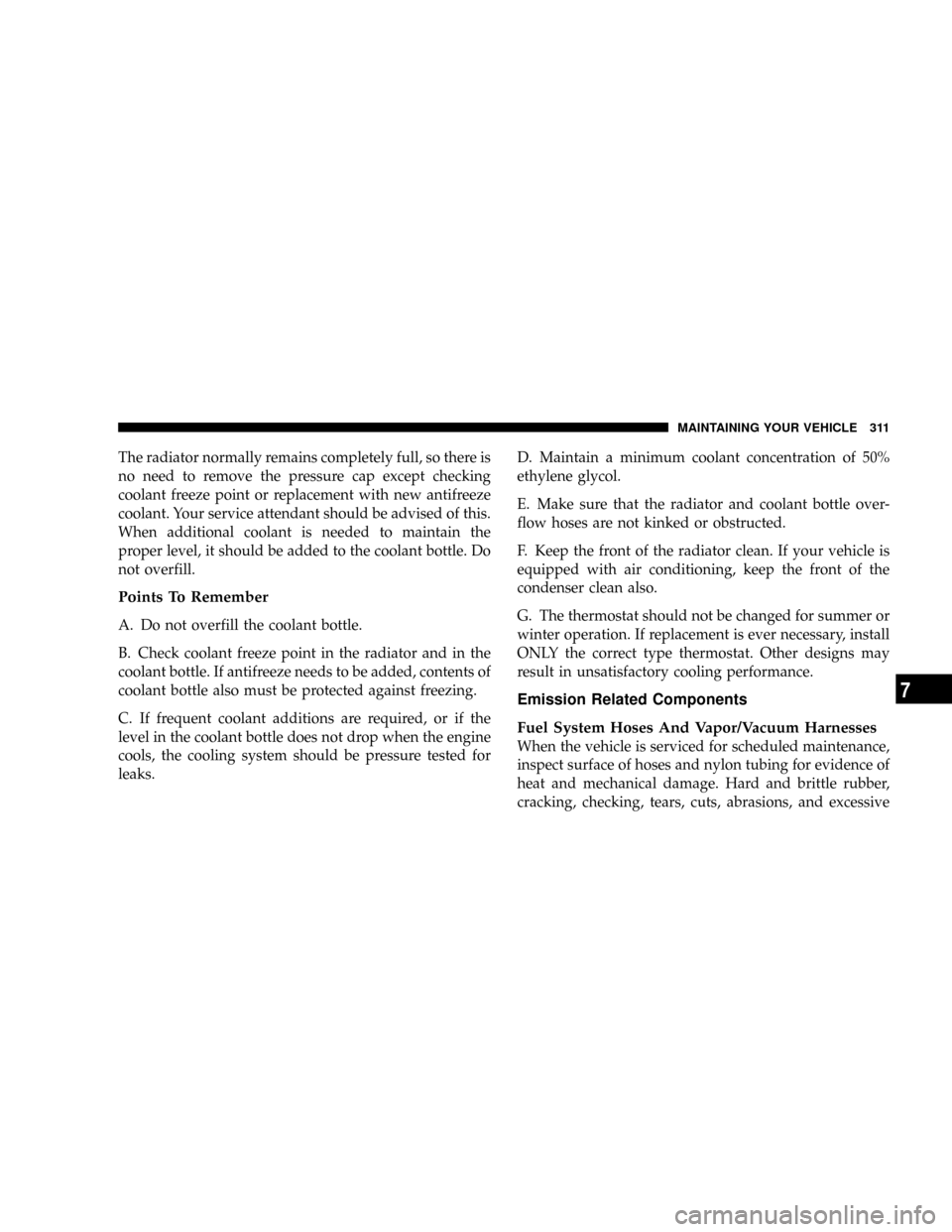
The radiator normally remains completely full, so there is
no need to remove the pressure cap except checking
coolant freeze point or replacement with new antifreeze
coolant. Your service attendant should be advised of this.
When additional coolant is needed to maintain the
proper level, it should be added to the coolant bottle. Do
not overfill.
Points To Remember
A. Do not overfill the coolant bottle.
B. Check coolant freeze point in the radiator and in the
coolant bottle. If antifreeze needs to be added, contents of
coolant bottle also must be protected against freezing.
C. If frequent coolant additions are required, or if the
level in the coolant bottle does not drop when the engine
cools, the cooling system should be pressure tested for
leaks.D. Maintain a minimum coolant concentration of 50%
ethylene glycol.
E. Make sure that the radiator and coolant bottle over-
flow hoses are not kinked or obstructed.
F. Keep the front of the radiator clean. If your vehicle is
equipped with air conditioning, keep the front of the
condenser clean also.
G. The thermostat should not be changed for summer or
winter operation. If replacement is ever necessary, install
ONLY the correct type thermostat. Other designs may
result in unsatisfactory cooling performance.
Emission Related Components
Fuel System Hoses And Vapor/Vacuum Harnesses
When the vehicle is serviced for scheduled maintenance,
inspect surface of hoses and nylon tubing for evidence of
heat and mechanical damage. Hard and brittle rubber,
cracking, checking, tears, cuts, abrasions, and excessive
MAINTAINING YOUR VEHICLE 311
7
Page 335 of 386
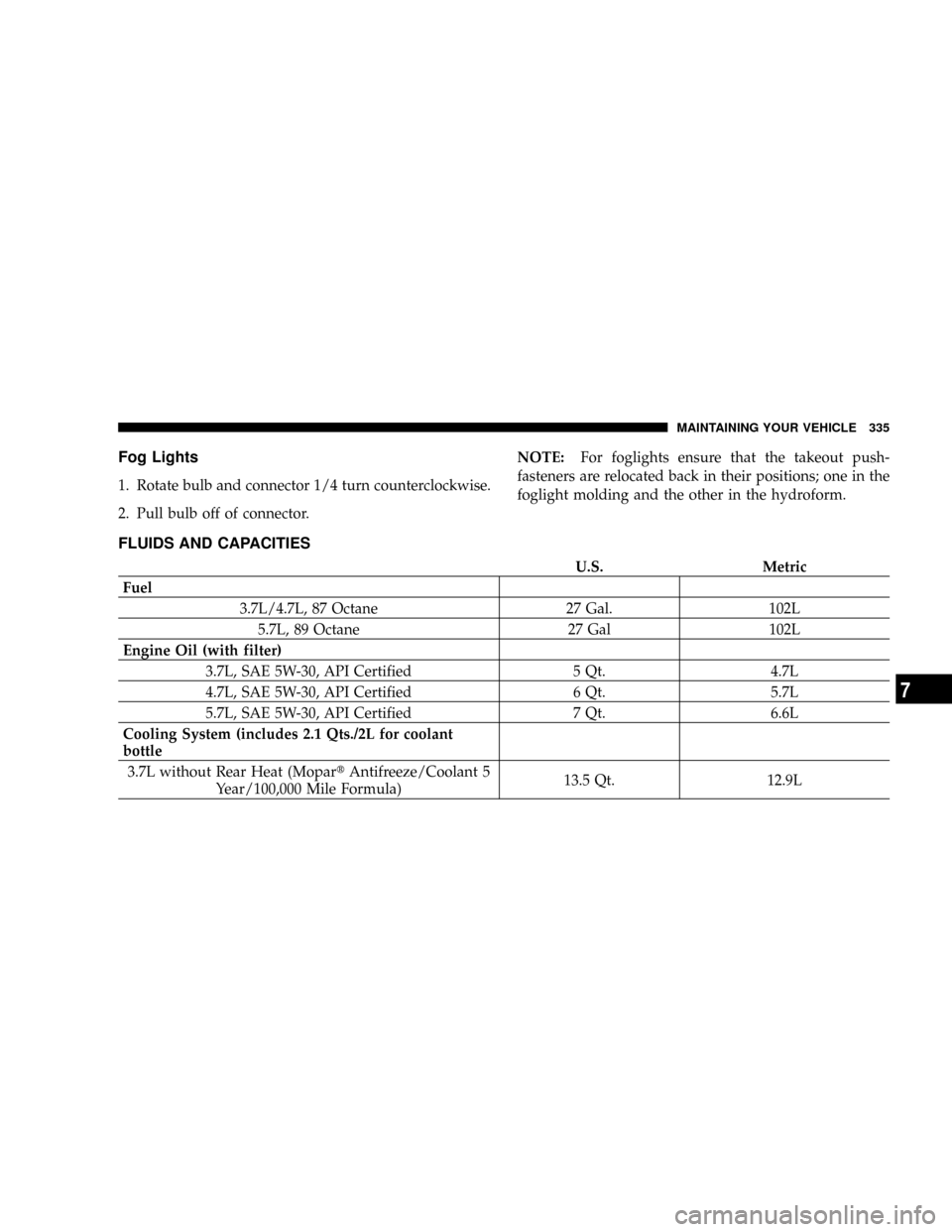
Fog Lights
1. Rotate bulb and connector 1/4 turn counterclockwise.
2. Pull bulb off of connector.NOTE:For foglights ensure that the takeout push-
fasteners are relocated back in their positions; one in the
foglight molding and the other in the hydroform.
FLUIDS AND CAPACITIES
U.S. Metric
Fuel
3.7L/4.7L, 87 Octane 27 Gal. 102L
5.7L, 89 Octane 27 Gal 102L
Engine Oil (with filter)
3.7L, SAE 5W-30, API Certified 5 Qt. 4.7L
4.7L, SAE 5W-30, API Certified 6 Qt. 5.7L
5.7L, SAE 5W-30, API Certified 7 Qt. 6.6L
Cooling System (includes 2.1 Qts./2L for coolant
bottle
3.7L without Rear Heat (MopartAntifreeze/Coolant 5
Year/100,000 Mile Formula)13.5 Qt. 12.9L
MAINTAINING YOUR VEHICLE 335
7
Page 337 of 386
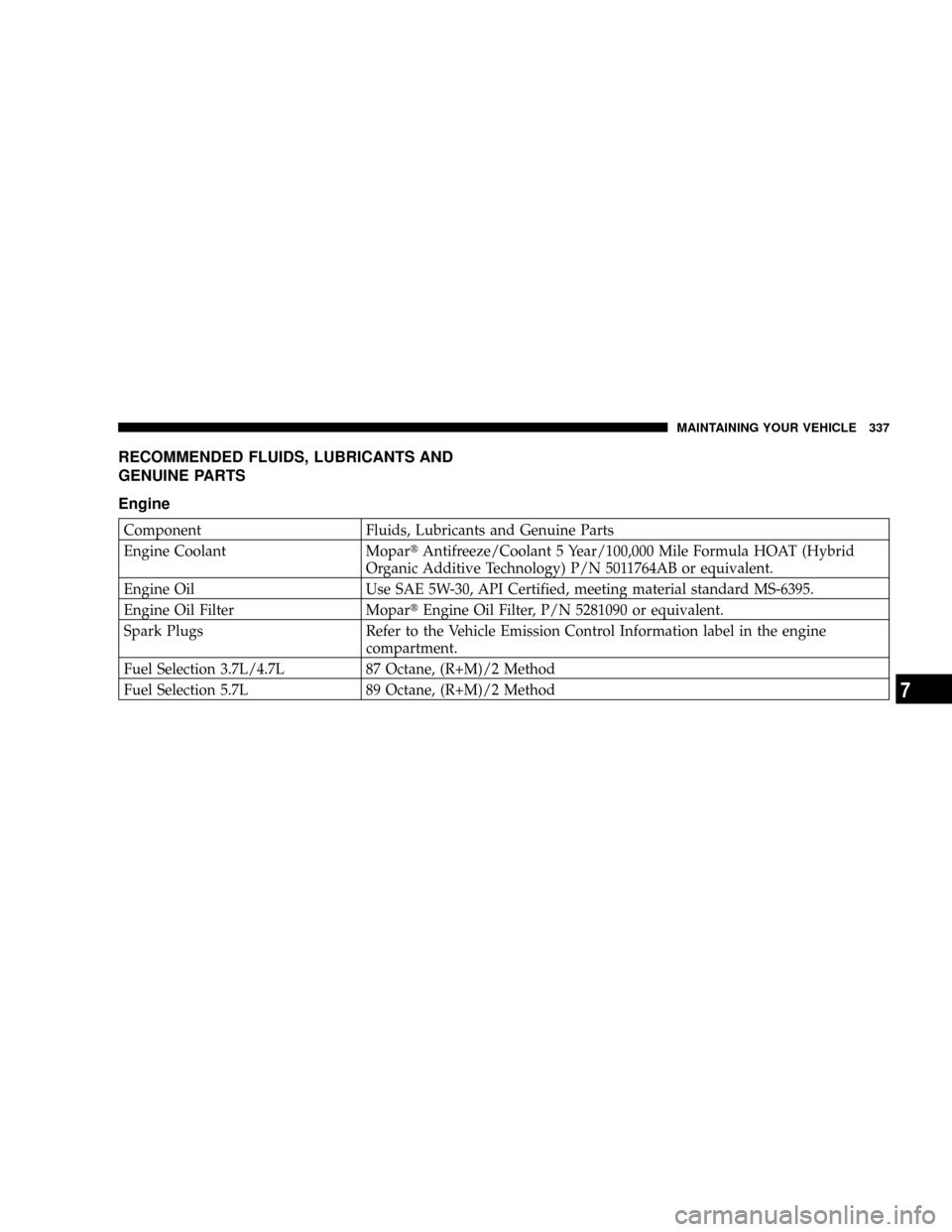
RECOMMENDED FLUIDS, LUBRICANTS AND
GENUINE PARTS
Engine
Component Fluids, Lubricants and Genuine Parts
Engine Coolant MopartAntifreeze/Coolant 5 Year/100,000 Mile Formula HOAT (Hybrid
Organic Additive Technology) P/N 5011764AB or equivalent.
Engine Oil Use SAE 5W-30, API Certified, meeting material standard MS-6395.
Engine Oil Filter MopartEngine Oil Filter, P/N 5281090 or equivalent.
Spark Plugs Refer to the Vehicle Emission Control Information label in the engine
compartment.
Fuel Selection 3.7L/4.7L 87 Octane, (R+M)/2 Method
Fuel Selection 5.7L 89 Octane, (R+M)/2 Method
MAINTAINING YOUR VEHICLE 337
7
Page 342 of 386
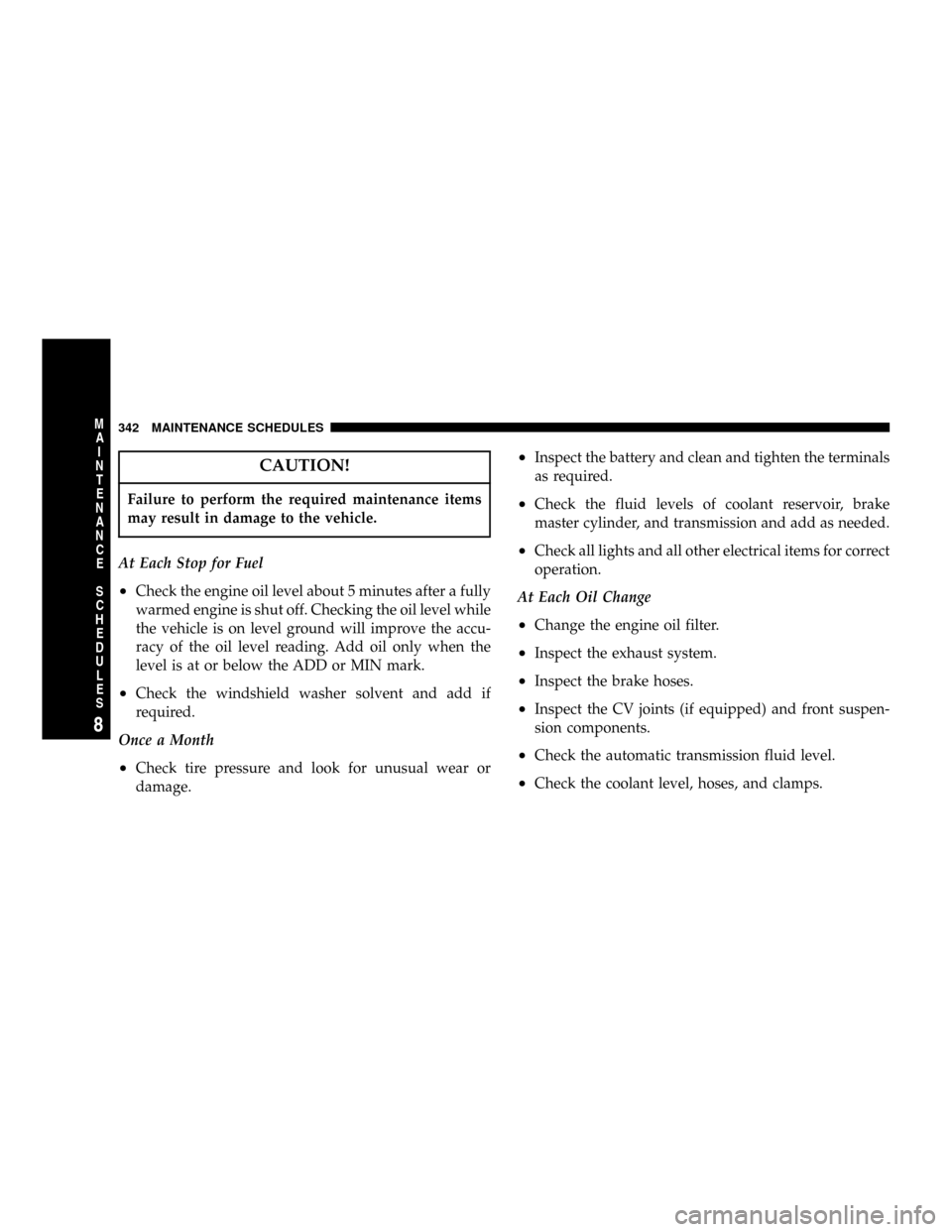
CAUTION!
Failure to perform the required maintenance items
may result in damage to the vehicle.
At Each Stop for Fuel
²Check the engine oil level about 5 minutes after a fully
warmed engine is shut off. Checking the oil level while
the vehicle is on level ground will improve the accu-
racy of the oil level reading. Add oil only when the
level is at or below the ADD or MIN mark.
²Check the windshield washer solvent and add if
required.
Once a Month
²Check tire pressure and look for unusual wear or
damage.
²Inspect the battery and clean and tighten the terminals
as required.
²Check the fluid levels of coolant reservoir, brake
master cylinder, and transmission and add as needed.
²Check all lights and all other electrical items for correct
operation.
At Each Oil Change
²Change the engine oil filter.
²Inspect the exhaust system.
²Inspect the brake hoses.
²Inspect the CV joints (if equipped) and front suspen-
sion components.
²Check the automatic transmission fluid level.
²Check the coolant level, hoses, and clamps.
342 MAINTENANCE SCHEDULES
8
M
A
I
N
T
E
N
A
N
C
E
S
C
H
E
D
U
L
E
S
Page 350 of 386
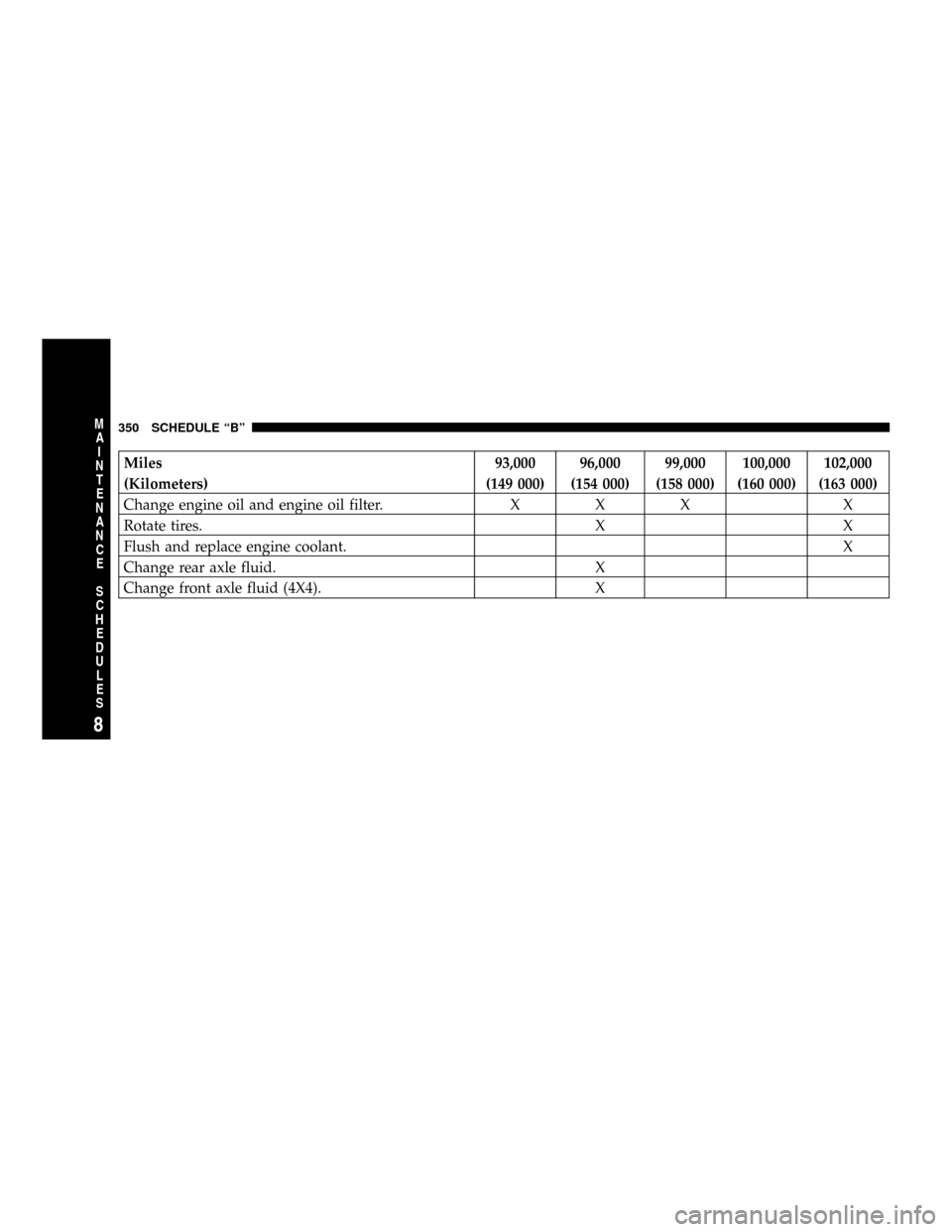
Miles 93,000 96,000 99,000 100,000 102,000
(Kilometers) (149 000) (154 000) (158 000) (160 000) (163 000)
Change engine oil and engine oil filter. X X X X
Rotate tires. X X
Flush and replace engine coolant.X
Change rear axle fluid. X
Change front axle fluid (4X4). X
350 SCHEDULE ªBº
8
M
A
I
N
T
E
N
A
N
C
E
S
C
H
E
D
U
L
E
S
Page 354 of 386
![DODGE DURANGO 2004 2.G User Guide Miles 36,000 42,000 48,000 54000 60,000 66,000
(Kilometers) (58 000) (67 000) (77 000) (84 000) (96 000) (106 000)
[Months] [36] [42] [48] [54] [60] [66]
Change engine oil and engine oil filter. X XXX DODGE DURANGO 2004 2.G User Guide Miles 36,000 42,000 48,000 54000 60,000 66,000
(Kilometers) (58 000) (67 000) (77 000) (84 000) (96 000) (106 000)
[Months] [36] [42] [48] [54] [60] [66]
Change engine oil and engine oil filter. X XXX](/img/12/5603/w960_5603-353.png)
Miles 36,000 42,000 48,000 54000 60,000 66,000
(Kilometers) (58 000) (67 000) (77 000) (84 000) (96 000) (106 000)
[Months] [36] [42] [48] [54] [60] [66]
Change engine oil and engine oil filter. X XXXXX
Rotate tires. X XXXXX
Check transfer case fluid level (4X4). X
Flush and replace engine coolant at 60
months, regardless of mileage.X
Inspect brake linings. X X
Replace engine air cleaner filter.X
Replace spark plugs.X
Inspect PCV valve, replace as necessary. *X
Inspect and replace ignition cables if
necessary (5.7L only).X
Inspect auto tension drive belt and replace if
required.X
354 SCHEDULE ªAº
8
M
A
I
N
T
E
N
A
N
C
E
S
C
H
E
D
U
L
E
S
Page 356 of 386
![DODGE DURANGO 2004 2.G User Guide Miles 102,000 108,000 114,000 120,000
(Kilometers) (163 000) (173 000) (182 000) (192 000)
[Months] [102] [108] [114] [120]
Change engine oil and engine oil filter. X X X X
Rotate tires. X X X X
Drain DODGE DURANGO 2004 2.G User Guide Miles 102,000 108,000 114,000 120,000
(Kilometers) (163 000) (173 000) (182 000) (192 000)
[Months] [102] [108] [114] [120]
Change engine oil and engine oil filter. X X X X
Rotate tires. X X X X
Drain](/img/12/5603/w960_5603-355.png)
Miles 102,000 108,000 114,000 120,000
(Kilometers) (163 000) (173 000) (182 000) (192 000)
[Months] [102] [108] [114] [120]
Change engine oil and engine oil filter. X X X X
Rotate tires. X X X X
Drain and refill tranfer case fluid (4X4). X
Flush and replace engine coolant, if not done at 60 mos. X
Flush and replace engine coolant, if not done at 102,000
miles (163 000 km)X
Inspect brake linings. X
Replace engine air cleaner filter.X
Replace spark plugs.X
Inspect PCV valve, replace as necessary.*X
* This maintenance is recommended by the manufacture
to the owner but is not required to maintain the emis-
sions warranty.³ This maintenance is not required if previously per-
formed.
356 SCHEDULE ªAº
8
M
A
I
N
T
E
N
A
N
C
E
S
C
H
E
D
U
L
E
S